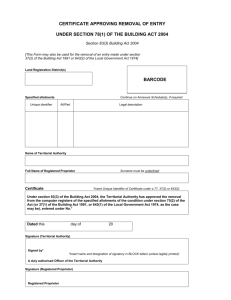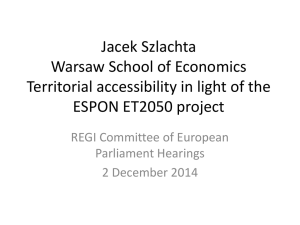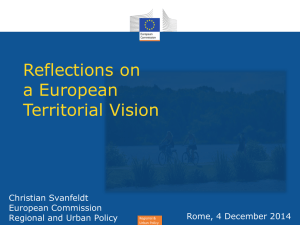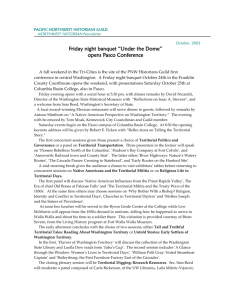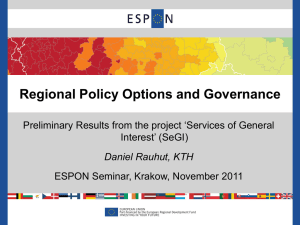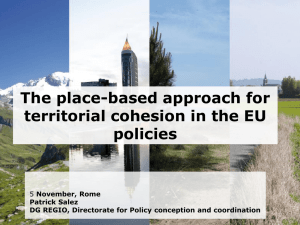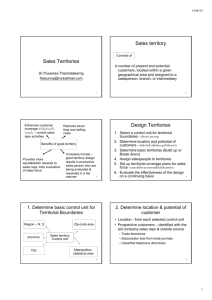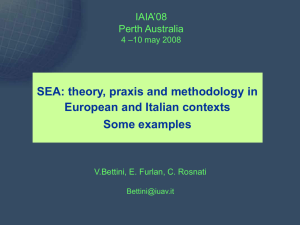SEA Manual
advertisement
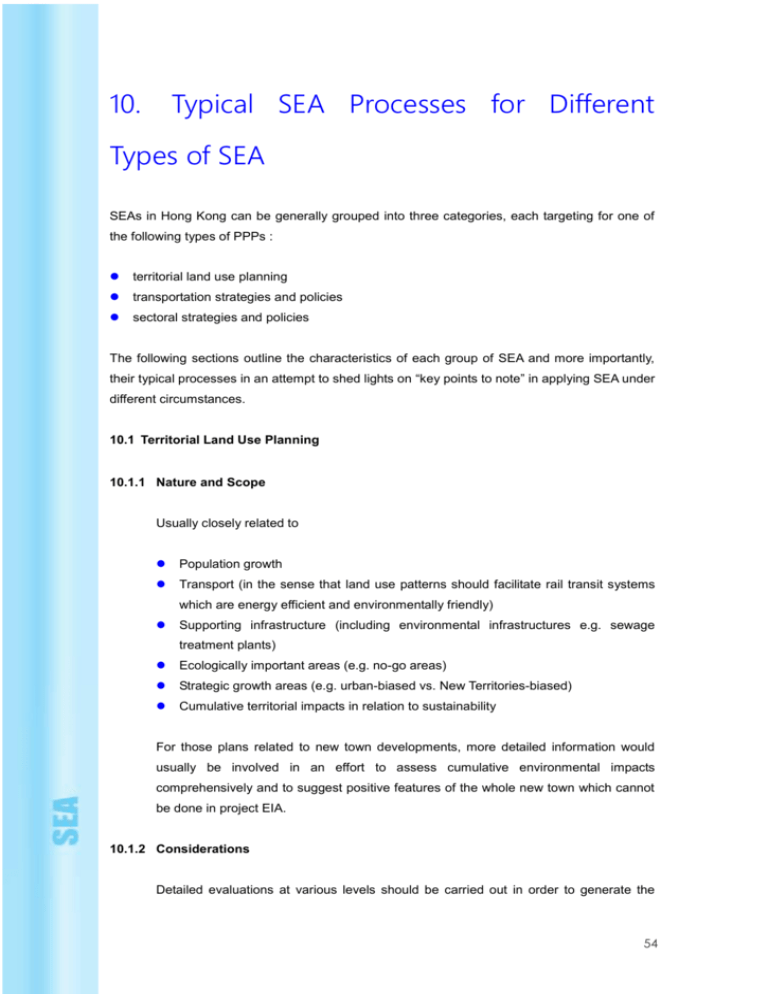
10. Typical SEA Processes for Different Types of SEA SEAs in Hong Kong can be generally grouped into three categories, each targeting for one of the following types of PPPs : territorial land use planning transportation strategies and policies sectoral strategies and policies The following sections outline the characteristics of each group of SEA and more importantly, their typical processes in an attempt to shed lights on “key points to note” in applying SEA under different circumstances. 10.1 Territorial Land Use Planning 10.1.1 Nature and Scope Usually closely related to Population growth Transport (in the sense that land use patterns should facilitate rail transit systems which are energy efficient and environmentally friendly) Supporting infrastructure (including environmental infrastructures e.g. sewage treatment plants) Ecologically important areas (e.g. no-go areas) Strategic growth areas (e.g. urban-biased vs. New Territories-biased) Cumulative territorial impacts in relation to sustainability For those plans related to new town developments, more detailed information would usually be involved in an effort to assess cumulative environmental impacts comprehensively and to suggest positive features of the whole new town which cannot be done in project EIA. 10.1.2 Considerations Detailed evaluations at various levels should be carried out in order to generate the 54 preferred options, which can then be synthesized into the development strategies. Environmental initiatives and objectives should be fully integrated into the overall planning process. As this type of SEA seeks to develop a plan with scale and types of developments being commensurate with environmental thresholds, stringent testing procedures should be developed and undesirable elements should be screened out at each stage of the plan formulation process. Moreover, as these landuse plans at strategic level provide for long term development guidance, opportunities should be seized to rectify existing landuse-related environmental problems. 10.1.3 Examples HK2030 (http://www.info.gov.hk/hk2030/hk2030content/news/cover.htm) and TDSR (http://www.epd.gov.hk/epd/english/environmentinhk/eia_planning/sea/territorial_dept.ht ml) are among examples of SEA of Territorial Land Use Planning. The key points of the examples are shown in Table 2 below while project descriptions of the study are in Appendix 1. Table 2 Examples of SEA Applying in Territorial Land Use Planning Study Key Sectors Involved Hong Kong 2030 : Territorial Land Planning Vision Use, and Strategy Transportation Territorial Development Strategy Review Territorial Land Use, Transportation Scale Dimension of Environmental Issues Territory wide land use, transport and ports planning up to 2030 Territorial Territory wide population from 6.8M in mid-1999 to 8.1M in 2011 Territorial District Strategic Environmental Concerns and Foci Potential environmental implications and acceptability of various development options. Key concerns were air, water, traffic noise and conservation. District Potential environmental implications and acceptability of various development options. Key concerns were air, water, traffic noise and conservation. 10.1.4 Process Since territorial or regional land use plans usually cover long time frames, and will lead to projects and developments over a long period of time, a comprehensive SEA is beneficial to identify major environmental problems at the outset and avoid problems which would be difficult and costly to resolve as projects are implemented at later stages. In the process, SEA are usually supported by comprehensive studies with public 55 consultation undertaken at the earliest possible stage. Regarding plans for new town developments, SEA would usually be conducted together with Engineering Feasibility Study which is a Schedule 3 project under the EIA Ordinance, requiring to follow the Ordinance’s procedures such as carrying out of public consultation. A typical SEA process for this type of PPP, by referring to the case of HK2030, is presented in Figure 17 below. Figure 17 A Typical SEA Process for Territorial Land Use Planning –The Case of Hong Kong 2030 : Planning Vision and Strategy 56 10.2 Transportation Strategies and Policies 10.2.1 Nature and Scope Aimed at facilitating the formulation of a “win-win” strategy/ policy which can best meet transport (social) and environmental needs plus financial/economic requirements. 10.2.2 Considerations For long term sustainability, the following issues are key factors to be considered: mode of transport; alternatives and needs; rail or road; alignment options; integration with environmental and landuse planning; traffic management and control; use of advance vehicle technologies. 10.2.3 Examples CTS3 (http://www.epd.gov.hk/epd/english/environmentinhk/eia_planning/sea/third_com p.html) and RDS2 (http://www.epd.gov.hk/epd/english/environmentinhk/eia_planning/s ea/second_railway.html) are among examples of SEA of transportation strategies a nd policies. The key points of the examples are shown in Table 3 below while project descriptions of the two studies are in Appendix 1. Table 3 Study CTS3 RDS2 Examples of SEA Applying in Transportation Strategies and Policies Key Sectors Involved Transportation Transportation, Fuel consumption, Land Use Scale Dimension of Strategic Environmental Concerns and Environmental Foci Issues Territory wide cross boundary population from 6.8M in mid-1999 to 8.9M in 2016 Territorial Territory wide cross boundary population from 6.8M in mid-1999 to 8.9M in 2016 Territorial District Local District Local Environmental implications due to different transport modes, polices and major development were identified. Environmental constraints on further strategic transport developments were examined in which key concerns were air pollution and traffic noise. Ecological profile was identified to avoid strategic transport infrastructures from being developed in environmentally sensitive areas. Formulating a preferred rail network that can maximize environmental benefits and avoid adverse environmental impacts as far as possible. Potential environmental implications due to the railway development options, including indirect effects and benefits of reducing air pollution were identified and compared with the use of road transport 57 10.2.4 Process In many cases, qualitative analysis is made together with quantitative evaluations with a focus on comparing different scenarios. As there would be many uncertainties and assumptions behind the scenarios, certain extent of “professional judgments” would be involved during the process. A typical SEA process for this type of PPP, by referring to the case of RDS2, is presented in Figure 18 below. Figure 18 A Typical SEA Process for Transportation Strategies and Policies – The Case of Second Railway Development Study 58 Focus of SEA for RDS2 Annex A – Economic Appraisal of the Environmental Costs and Benefits of New Railways Traditional Project Appraisals in Hong Kong Environmental Valuation Tools Environmental Economics and Railway Development Mechanisms for “Capturing” Benefits to the community Annex B – Comparative Assessment of Road vs. Rail Project appraisal of Highway and Railway projects Air quality implications Noise performance Landtake and landuse implications Transport safety 10.3 Sectoral Strategies and Policies 10.3.1 Nature and Scope Usually for very major infrastructure / facilities at an early stage; Usually high profile and restricted access during the course of SEA; Timely environmental inputs are important, especially for different sitings. 10.3.2 Considerations Linkages between policy action and environmental issues are key to the SEA. Using trade and environment as an example, it is important to map out the environmental effects of trade agreements at the early stage in order to properly complete a SEA. Usually need to consider alternative sites over the territory, among other issues including major environmental constraints, e.g. ecologically sensitive areas, air sheds, population centres. Other alternatives, apart from siting, would also need to be considered, e.g. consideration on the use of natural gas and other fuel options in a strategic power supply proposal. 59 10.3.3 Examples Extension of Existing Landfills and Identification of Potential New Waste Disposal Sites (http://www.epd.gov.hk/epd/english/environmentinhk/eia_planning/sea/waste_disposal_ sites.html), is one of the SEA examples for Sectoral Strategies and Policies. The key points of the example are shown in Table 4 below while project descriptions of the study are in Appendix 1. Table 4 Examples of SEA Applying in Strategic Proposals and Options Key Sectors Involved Land Use Compatibility, Landfill Technology, Waste Planning, Scale Across HK Territory Dimension of Environmental Issues Territorial District Local Strategic Environmental Concerns and Foci Potential environmental implications and acceptability of various site and landfill technology options. Key concerns were waste, water, air quality and ecological impacts. Design of Facilities 10.3.4 Process For PPP proposals which are land-related, the process usually begins by identifying the “Areas of Absolute Exclusion” where project at those areas would not be permitted. It is then followed by environmental screening of a list of possible sites identified. The selection process can be carried out in stages, during which long-listed sites could be screened at a board brush level taking into account the relatively important criteria while further environmental evaluation and screening could be applied for short-listed sites at a more detailed level to ascertain their likely environmental implications. 60 A typical SEA process for this type of PPP, by referring to the case of “Extension of Existing Landfill and Identification of Potential New Waste Disposal Sites”, is presented in Figure 19 below. Figure 19 A Typical SEA Process for Sectoral Strategies and Policies – The Case of “Extension of Existing Landfill and Identification of Potential New Waste Disposal Sites” 61

